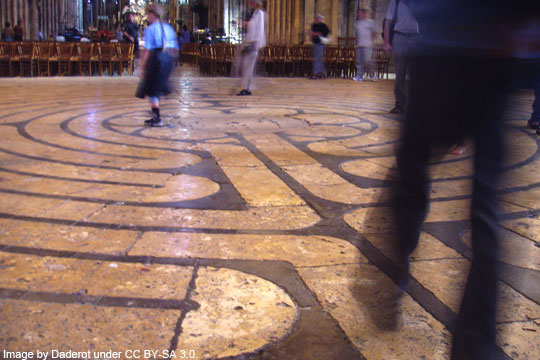
One of the mistakes we make in adult catechesis when it comes to prayer—one of the six tasks of catechesis—is that we talk about prayer instead of simply engaging people in experiences of prayer and then unpacking those experiences later. I have learned that a very effective tool for engaging people, especially beginners, in the life of prayer is the labyrinth.
A labyrinth is a circular pattern with a cross at its center, and a person walks that pattern as a spiritual practice. The labyrinth might be a permanent outdoor structure made of stone and earth, or it could be a large patterned cloth that can be spread on the floor for walking and stored away when not in use. The purpose of walking a labyrinth is to engage one’s heart, mind, and body in a contemplative experience symbolic of our spiritual journey in life. The experience of walking the labyrinth can be thought of as a pilgrimage-in-place. Walking the labyrinth is an experience of solitude and is done thoughtfully, at one’s own pace and in silence. While walking the path, one can meditate on a Scripture passage or on the Stations of the Cross, pray the Rosary, or just use the time to engage in conversation with God.
Christians need not be concerned that the labyrinth traces its roots to paganism since the circle and the journey are so intrinsic to human nature that most cultures and religions have used them. Over the centuries, Catholics have transformed more than a few pagan customs into spiritual practices (e.g. choosing to celebrate an important feast in December). It is precisely the goal of the Gospel to affirm those elements of culture that are in line with the Gospel and to purify and transform those that are not. One of the world’s most famous labyrinths can be found in the Chartres Cathedral in France. Having said all that, we should also be wary of any new-age thinking that occasionally seeks to associate itself with the practice of walking the labyrinth.
Recently, I came across this blog post from Heather Plett about how to create your own inexpensive portable labyrinth, and I thought you’d enjoy it. Perhaps some of you out there might use it to invite adults to enter more deeply into a life of prayer. If you are doing so or plan to do so, please let me know of your experience!
Image by Daderot under CC BY-SA 3.0.




I am trying to raise the money to have our Catholic parish buy a canvas labyrinth. I am finding it hard to answer the question of “why should it be our parish to have a labyrinth?” The only answer I have to that specific question is that I found out that no other parish in the Nashville diocese has one. Could you help me with some substance to that question ASAP?
Jane, at a time when many people are saying they are “spiritual but not religious” and are leaving the Catholic Church because they don’t feel their spiritual needs are being me, I believe there is every reason in the world for us to provide opportunities for spiritual enrichment for people. A labyrinth is simply one such opportunity for people to engage in a spiritual activity that can help them to meditate/contemplate on God’s presence and movement in their lives.